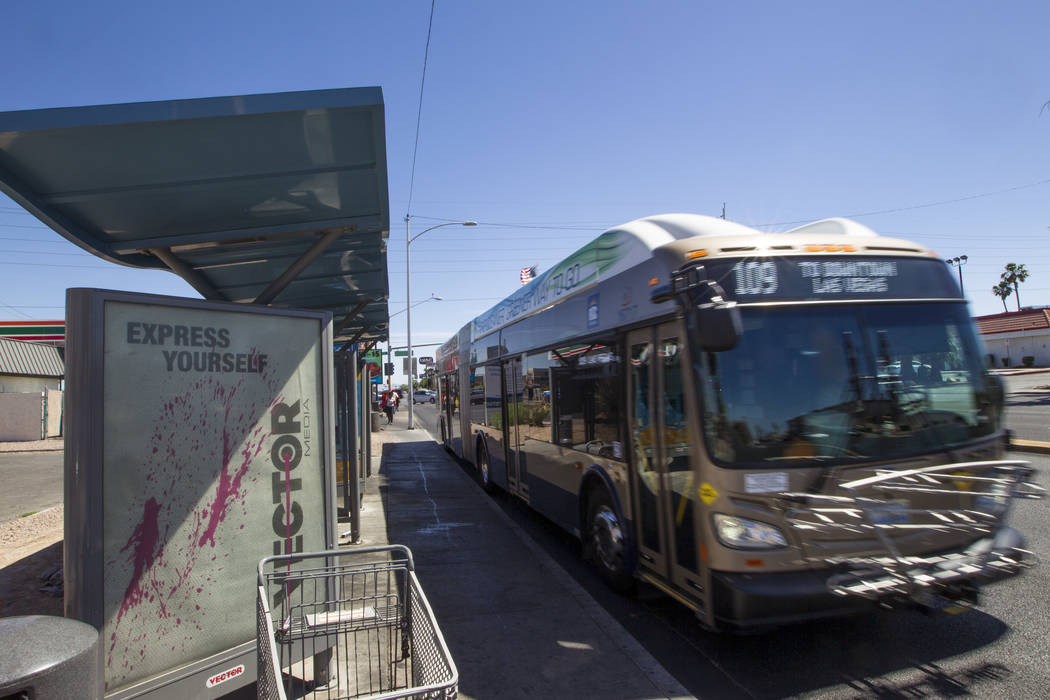RTC made right choice derailing light rail for Maryland Parkway
Despite the attractiveness of adding light rail to the city and the overwhelming public support for it as the transportation mode of choice for the Maryland Parkway corridor, transit officials made the right choice in selecting bus rapid transit for the 8.7-mile stretch.
The bus rapid transit system preferred by the Regional Transportation Commission of Southern Nevada board of commissioners features an in-street design with dedicated bus lanes that can be used as turn lanes when buses are not present. The plan also calls for a bike lane off the main road, with the bus lane providing an added barrier between automobiles and bicyclists.
When the decision to choose bus rapid transit came Thursday morning, despite 72 percent of the public preferring light rail, the RTC weighed the decision heavily on the price of each option.
Commissioner Larry Brown expressed his concern regarding light rail based on what he’s read about other systems, stating the projects seldom come in on time and on budget.
This was made immediately clear as David Swallow, the RTC’s senior director of engineering and technology, presented the three alternatives to the current bus system running on Route 109.
Swallow reported the light rail system that has been touted as a $750 million project since 2016 — including during the final public meetings and open comment period that concluded last month — was now pegged at $1 billion.
The $250 million increase (33.3 percent) was attributed to a changing construction market over the past three years, Swallow said.
Bus rapid transit also saw a $10 million increase (3 percent), going from its $335 million original cost estimate to $345 million, while the upgrading of Route 109’s cost stayed steady at $29 million.
Funding for the bus rapid transit option was also already identified, relying heavily on federal funding with the remaining money coming from fuel revenue indexing funds. But that wasn’t the case with light rail.
The light rail option also would have been dependent on federal funding, but $380 million would have come by way of a special interest district tax ($50 million) and a sales tax increase ($330 million) if private sector funding — which wasn’t identified — didn’t come through. The sales tax increase also would have had to be approved by voters — which wasn’t a given despite their support of the light rail option in the RTC survey.
Additionally, the permanence of light rail was a concern for commissioners, which is warranted at a time in which the transportation realm is changing at a rapid pace due to technology advancements.
Advancements in autonomous vehicles and other transportation options could cause already declining bus ridership in the valley to dip even further.
RTC bus ridership has dropped from 66 million riders in 2016 to 63.7 million in 2018, with ride-hailing apps like Uber and Lyft being cited as one possible reason for the decline.
If light rail was chosen and the projected ridership didn’t reach projections, the RTC would be in danger of losing money on the system, especially with the operating and maintenance costs being almost double that of the bus rapid transit system.
Also, if tweaks need to be made to adjust to ridership, bus rapid transit would be easier to address than the light rail option.
So, despite the potential economic development that might have occurred with a light rail system, the potential financial and ridership shortfalls mean the RTC made the smart — but likely not the most popular — decision in the end.
Distracted driving enforcement
Distracted drivers may catch a surprise greeting from area law enforcement as they launch a focused effort on ticketing motorists not focused on the road.
The 10-day-long enforcement, which kicked off Friday and runs through April 22, features various agencies working together to urge motorists to keep their eyes on the road and put away cellphones or other items that cause distractions.
On average, texting takes your eyes off the road for 4.6 seconds and when traveling at 55 mph, that is enough time to cover the length of a football field, according to Nevada Highway Patrol.
In 2015, 3,477 deaths on roadways were attributed to distracted driving, according to the National Highway Traffic Safety Administration.
Distracted driving is any activity that takes a driver’s attention away from driving, including talking or texting on your phone, eating, drinking, talking to people in your vehicle, adjusting the radio, entertainment or navigation system.
Nevada’s no texting/electronic device usage while operating a motor vehicle law was enacted in 2011.
The law allows for hands-free electronic communication while driving. First responders and emergency personnel are exempt from the law while on duty and responding to an incident as are drivers using their cellphone to contact 911 after witnessing an incident.
“The Nevada Highway Patrol is reminding drivers that taking your eyes off the road, even for one second, can change your life or someone else’s life forever,” NHP said in a statement. “Put down the distractions and drive safe, Nevada.”
Send questions and comments to roadwarrior@reviewjournal.com. Please include your phone number. Follow @RJroadwarrior on Twitter. Contact Mick Akers at makers@reviewjournal.com or 702-387-2920. Follow @mickakers on Twitter.























